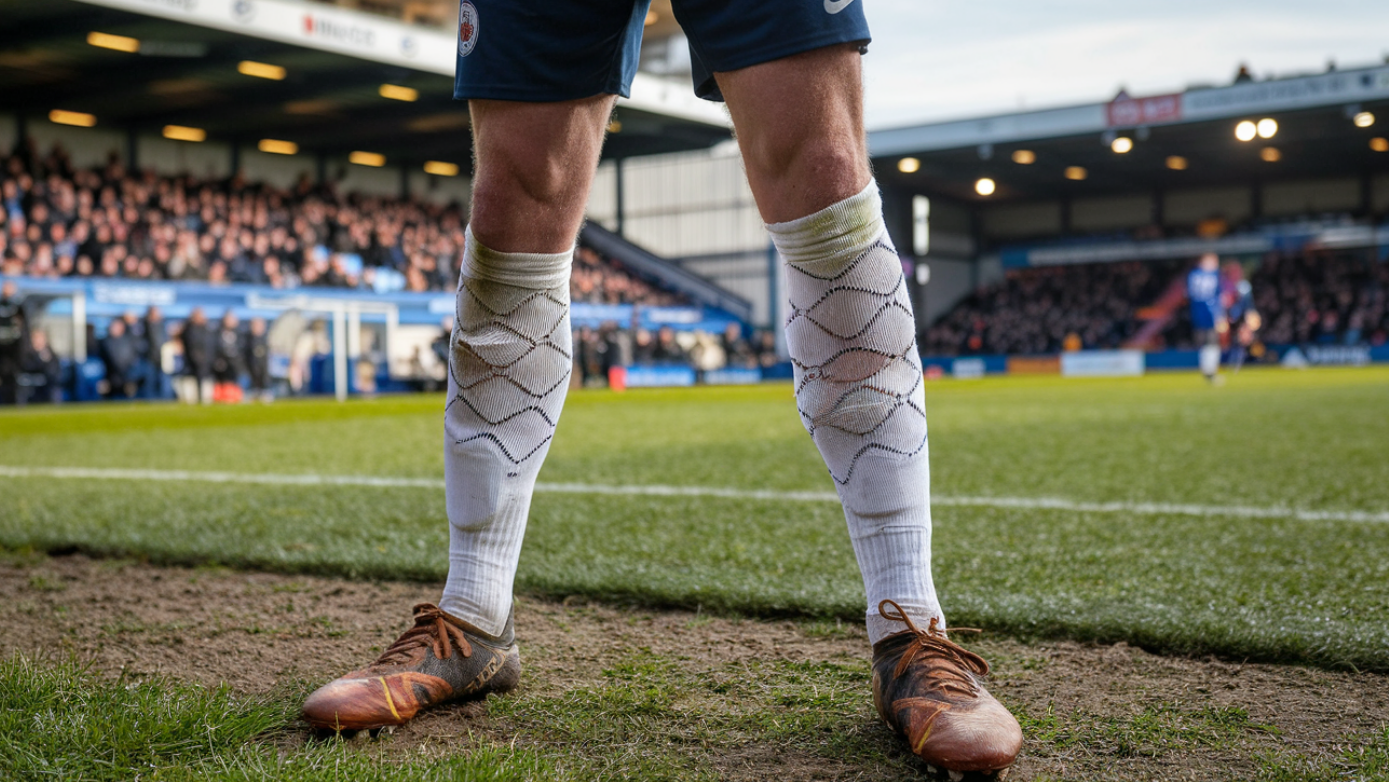10 Fascinating Reasons Why Footballers Cut Holes in Their Socks
Key Takeaways
- Circulation. This one simple action reduces the chance of cramping and fatigue by relieving pressure on the legs. This ensures maximum performance when it comes time to play a match.
- Players enhance comfort by increasing breathability and reducing tightness in their socks, allowing for easier movement and focus on the game.
- Cutting holes in socks reduces friction and increases airflow. This easy modification minimizes the chances of developing blisters, chafing, and dangerous moisture accumulation to keep your feet healthier.
- Personalising sock designs allows footballers to express individuality, create a unique look, and align with their personal preferences or team identity.
- By cutting holes in socks, pro athletes are improving ventilation, helping regulate temperature, keeping feet from overheating or getting too sweaty.
- Customising socks provides more flexibility and movement freedom, enabling quick reactions and natural motion essential for optimal football performance.
Footballers cut holes in their socks so that the pressure from tight-fitting socks and shin pads can be relieved while playing in-game. Today’s football socks are designed to fit tightly to the calf to increase grip. Unfortunately, this snug fit can lead to chafing and cut off circulation, especially along the calves.
Cutting holes in the socks lets players keep their feet and legs from cramping up, which would be detrimental to their performance. This simple change goes a long way in preventing not only blisters, but overall skin irritation due to increased friction.
The second reason is it does provide more flexibility and comfort. This is especially critical for athletes who need to change direction quickly and repeatedly throughout the match. By customizing their equipment like this, footballers are able to have both a snug fit and total freedom of movement.
1. Improved circulation for better performance
When it comes to serious performance, the most important reason cutting holes in socks is the best way to go is improved circulation. Dr. Stefaan Vossen explains that custom-shaped holes can enhance effective blood flow, providing a real-world physical benefit. Top footballers such as Jude Bellingham and Bukayo Saka regularly adopt a similar approach off the pitch to ensure they are performing at their best on it.
Kyle Walker made a great point recently about football socks, stating that the socks are too tight and circulation is being cut off. He particularly mentioned the pressure on his calves from socks that were too tight, which can lead to injury during a match. Many footballers are beginning to embrace this practice as a solution.
The second most common reason to engage in this practice is to reduce tension and pressure. Jermaine Jenas emphasized that by cutting the socks, it relieves stress in the calves, an important area while playing in a game. This quick fix doesn’t just help avoid soreness - it promotes better circulation so you can perform at the top of your game, even when the pressure’s on.
Inadequate circulation can cause muscle cramps, which can sideline a player. The socks’ compression effect helps to combat fatigue as well. Dr. Vossen noted that this strategy can delay fatigue by 30% in sustained exercise, allowing premier league footballers to maintain their stamina more efficiently.
In turn, athletes are able to maintain their stamina more efficiently. This tactic allows athletes such as Bukayo Saka and Kyle Walker to perform at their peak with less post-match inflammation.
2. Enhanced comfort during intense matches
We found that adding holes to our football socks greatly improved airflow, resulting in players feeling more comfortable even in the most intense matches. This new design increases ventilation, letting air flow freely to avoid overheating and sweating for the ultimate irritation-free experience. Players including Kyle Walker have made the tactic their own.
From an in-game stamina standpoint, it’s allowing them to keep their legs a little cooler, a little looser. Too much pressure around the calf muscles can limit movement and lead to pain, especially if the socks are too tight. By cutting holes, players reduce this tension to increase blood flow and create freer, more natural movement.
This simple change makes sure that they can keep their mind on the game itself, without worrying about any painful distractions. Gareth Bale, for instance, utilised this method during his Real Madrid days to manage recurring muscle injuries, ensuring he stayed match-ready. Customising socks with holes also allows players to have more control over the fit to better suit their individual preferences.
Other players, such as Jack Grealish, opt to roll their socks down past their calves to reap the same rewards. Some enjoy the comfort and versatility that sock-hole-cutting provides. As Dr. Raj Brar explained, that idea is actually very similar to what high-pressure compression socks do. It prevents calf strain and cramps while increasing overall comfort and performance.
3. Reduced risk of blisters and chafing
Punching holes in socks reduces the friction between the sock and the skin, reducing the likelihood of blisters forming. Tight-fitting socks can rub against sensitive areas, especially during intense movement like running or quick direction changes. By piercing the upper material, players create far fewer contact points that are in contact with the foot, greatly decreasing the likelihood of chafing.
It’s a strategy that many footballers have taken up – even Jude Bellingham has been rocking it – to help them feel more comfortable on the pitch. Socks that are too tight can lead to chafing, especially around the toes and lower leg/calf area. By cutting holes in the fabric, pressure is alleviated, and thereby, the material can sit more comfortably against the foot.
This is particularly beneficial for those in professional fields who utilize compression socks during downtime away from games for muscle recovery. This small modification prevents the sock from cutting into the skin allowing for a much more comfortable wear.
Better airflow is a great benefit. The added ventilation through holes in the sock help moisture escape while preventing foot blistering by ensuring the feet stay dry and comfortable. Since high levels of perspiration are a major contributor to blisters with the creation of painful hotspots, advanced ventilation is a huge help.
Kyle Walker has talked in the past about how this technique has allowed him to keep his feet in top condition.
4. Personalisation for unique player style
Personalization is key to bringing in the new generation of footballers. This is why many professional footballers need to make customizations, like cutting holes in their socks. These changes provide players an opportunity to express their individuality with custom sock designs, enhancing their overall football kit.
Gareth Bale and Jude Bellingham have been known to cut holes in their socks to alleviate muscle pain and increase effective blood flow. This serves as an example of how personal needs can inform personal style. Jack Grealish doesn’t wear shin pads and rolls his socks under his calves, showcasing his extreme flair. This down-to-earth decision makes him a standout player on the field.
With all of these changes, colors pop, and players will look completely different from each other. Kyle Walker has previously been seen with holes in his socks, making his style choice on the pitch hard to miss. Beyond aesthetics, these alterations foster a sense of identity and belonging within teams, as players bring their unique flair while supporting shared goals.
Changes such as rolling socks or cutting holes are similarly both practical and in touch with personal style. Physiotherapist Nicki de Leon explains that many players, including Grealish, aim to reduce calf pressure to maximise muscle blood flow.
I know that eighty percent of footballers wear socks that are too tight. These changes encourage more innovation around legwear and ultimately lead to increased comfort for athletes.
5. Temperature regulation for foot health
Today, football kit alterations like holey socks are central to regulating temperature and ensuring good foot health on the field. With the level of physical exertion that professional footballers endure, their feet can quickly become warm. These holes, by allowing increased airflow, provide effective temperature regulation, keeping feet cool and comfortable.
For example, players like Kyle Walker have cut sock holes to address tightness and pressure, which improves ventilation around the toes. In addition to causing general discomfort, overheating can result in blisters and other serious foot conditions. Cutting holes stops this by letting the heat escape to cooler regions, allowing a more balanced, healthy environment.
This practice also complements the sweat-wicking properties of current socks. Keeping feet dry helps players prevent fungal infections, which are known to flourish in moist environments. Take Jude Bellingham, for instance, who personalizes his socks to give him maximum comfort and control on the pitch.
As the weather changes, football fans can appreciate this smart technique, as it allows players to stay in the zone - whether on a balmy summer afternoon or a brisk match night.
Calf strain is one of the most common injuries in football, affecting close to 70% of footballers. Cutting holes in socks has been shown to decrease this pressure and has turned into a pragmatic, personal solution for many players.
6. Increased flexibility and movement freedom
Puncturing holes in football socks increases dynamic flexibility and freedom of movement, particularly in the ankle and calf region. Because modern football socks are made of up to 90% polyester, they can be incredibly compressive. This tightness means increased tension on the calves, which can further limit mobility.
By cutting small holes, players like Kyle Walker and Jude Bellingham reduce this pressure, enabling freer movement and a more natural playing experience. Cutting down limitations is crucial for rapid shifts on the area. When it comes down to those ultimate championship matches, those quick cuts, those explosive accelerations are a must.
Restricting this movement with tight evenly socks can inhibit these natural strides and movements, as well as cause pain. Holes in the socks increase circulation and decrease swelling, allowing players to be more mobile during the game. As mentioned by Dr. Raj Brar in our podcast about hoof health, maintaining calf pressure is crucial.
He even advocates wearing compression socks on off days to help with recovery. This shift helps with responsiveness and performance, too. Other players, including Jack Grealish, are known to roll their socks down below the calves for the same purpose.
As many as 1 in 10 players in lower divisions follow suit, understanding its part in improving mobility and freedom of movement. The ability to move more organically, without unnatural restrictions, has a huge impact on players’ experience and gameplay.
7. Psychological edge through superstition
For footballers, personal rituals are a cornerstone of their game day preparations. If cutting holes in your socks provides you that psychological edge by following these routines, go for it. It’s not only a question of comfort or practicality, for some it’s about feeling more prepared. Superstition provides a psychological edge.
Many players will swear that putting on fresh socks can provide the winning edge. They usually put on the same lucky pair of white athletic socks that they’ve trained in all week. Thick socks like these are commonly used for the psychological edge, providing a nice, reassuring feel.
These practises also imbue psychological edge, as reassuring routines help settle pre-match nerves. By sticking to their own process, players can feel like they have more agency over their performance. By limiting these rituals, like over-managing how players can wear their socks, you can take away their creative freedom and individuality.
This constricting box can insidiously affect their mentality out on the field. Superstitions like these help build culture among the team as well. In response, some clubs have started offering bespoke kits with sock sleeves from manufacturers such as Hope & Glory to cater for this.
The shared quirks and practises add another layer of psychological edge, bringing players closer and making them feel invincible. Finally, taking on winning habits, like sock cutting, will further bolster your mindset towards getting those better results. Even the advantage is psychological, it still has a positive effect.
8. Easier sock removal post-game
When you’ve just finished the game of your life, yanking off constricting tight socks can feel like an ordeal. The removal process can be tedious, but cutting holes in socks makes it a lot easier. That’s because it relieves pressure from your calf muscles, which can feel constricted by the snugness of performance socks. Many footballers have found that introducing holes helps enhance their legwear experience.
Players like Kyle Walker have noted that overly tight socks can cause discomfort, making removal even trickier after a game. By integrating holes into their sock design, the tension is released, providing a faster and less aggravating experience for premier league footballers.
When it’s sock removal time after the match, tight socks make the removal process far more painful, not ideal for players suffering from post-match tiredness. The compression effect works to minimize swelling and fatigue as you play. It can turn sock removal after a game into an epic battle.
Punching holes solves this issue, allowing players to change into recovery apparel with less pressure. Real Madrid’s Jude Bellingham and Brazil’s Neymar have both been seen playing in holey socks at the FIFA World Cup, showcasing this trend among international footballers.
After a game, efficiency is of utmost importance. With less time spent wrestling with their tightest socks, players can spend more time on recovery routines. Though illegal in Spain, the practice is still widely used elsewhere to improve comfort and reduce stoppages.
9. Custom fit for individual foot shape
By cutting down their socks, players can custom fit them to whatever foot shape and size they may have. Professional footballers have specific needs that generic socks just can’t provide. Jamshedpur FC’s Pratik Chaudhari likes wearing anti-slip socks for grip. In order to keep his footing steady to the ground and quick as a cat, he always trims his garters just above the ankle.
For players with broader feet or high arches, customising socks can relieve tightness and improve circulation, which reduces discomfort caused by restrictive materials. Legwear alterations keep your feet comfy and stable while you work your magic on the court.
We heard some stories, like Kyle Walker from Manchester City literally started cutting holes in his socks. This quick fix alleviated tension on his calves and increased his athleticism. This small adjustment can help protect against blisters, swelling, or numbness, bringing players comfort and helping them stay focused on the game.
Former Valencia player Ezequiel Garay was forced to change his socks due to strict club dress code regulations. This points to the difficult line that athletes need to tread between functionality and rules.
Safety is the other major component. Ill-fitting socks lead to higher levels of injuries, including ligament strain or loss of movement ability. By trimming and modifying their socks, players get the perfect balance of comfortable stretch and secure fit.
More than 80% of footballers experienced improved comfort and performance after using this technique.
10. Trend influence from professional players
In recent months, cutting holes in football socks went viral. Having initially gained traction among male players, it has become a popular option for female athletes. Today’s football socks are made with as much as 90% polyester. On the flip side, their tight and stretchy design can be more than a little uncomfortable for some players.
By creating holes, footballers can alleviate pressure on their calves, improving blood circulation and performance while playing on the field. Professional players such as Jack Grealish like to keep their socks low to get the same type of effect. High-profile players such as Gareth Bale, Jude Bellingham and Kyle Walker have recently shed light on this controversial practice.
Bellingham has quite provocatively asserted that the new socks better accommodate the muscular frame of today’s professional footballer. In the meantime, Walker says the modification has cured his tight calf muscle and improved his longevity. Despite criticism from figures like Richard Keys and regulations in leagues like La Liga against damaged gear, players continue the trend.
Enforcement of that frequently isn’t happening, with even big name players like Bellingham wearing cut-up socks even when there are rules in place. This method has impacted younger players, who seek out professionals to inspire them. More telling than its sudden success is the embodiment of this trend in football gear, where elite players are directly influencing grassroots trends.
A powerful ripple effect is illustrating new priorities in comfort and performance.
Conclusion
While footballers cutting holes in their socks can sound strange at first, it provides some really smart advantages. This allows for improved circulation, keeping the foot cooler and increasing comfort while reducing the risk of blisters. That extra flex and fit really helps to find comfort in those high pressure moments of a tight match. For some, it’s an aesthetic choice or a superstition, while others say it simplifies post-game sock washing. Of course, the influence of professional players setting trends is at work here.
Whether it’s about performance or just personal preference, one thing is for sure: Those sock holes have an explanation well beyond what appears on the surface. If you’re interested in giving it a shot, think through what approach is right for you and your goals. Come back for more tips on the finer points that will sharpen your on-field performance.
Frequently Asked Questions
Why do footballers cut holes in their socks?
Footballers cut holes in their socks to lessen pressure on their calf muscles, enhancing effective blood flow and preventing chafing from tight socks during matches.
Does cutting holes in socks help with blisters?
Cutting holes in traditional socks can, indeed, reduce the risk of blisters for professional footballers. This alteration reduces friction and improves airflow, keeping their feet drier and minimizing irritation while they’re on the pitch.
Is cutting holes in socks a trend among professional players?
Of course, many professional footballers have taken the lead on this one, setting a fashion statement with their legwear. This influence encourages amateur and younger players to adopt similar styles for both functional and stylistic reasons.
Can cutting holes in socks improve foot flexibility?
By cutting away unnecessary, restrictive fabric from traditional socks, many footballers are able to create more freedom of movement, improving flexibility and performance on the pitch.
Is there a psychological reason behind this habit?
For many footballers, cutting holes in their socks is a quirky superstition that serves a good reason; it provides them with a psychological advantage, helping them feel more confident and focused while on the pitch.
Does cutting holes in socks help with temperature regulation?
Oh yes, most definitely. The added ventilation from the multiple holes in the socks keeps feet cool, preventing overheating and sweating, which is essential for a comfortable game.
Are there risks to cutting holes in football socks?
There are very few risks if done properly when altering legwear, but cutting holes that aren’t precise can compromise the structural integrity of the sock or lead to ripping, which is a good reason to ensure a clean cut for durability.




















Leave a comment